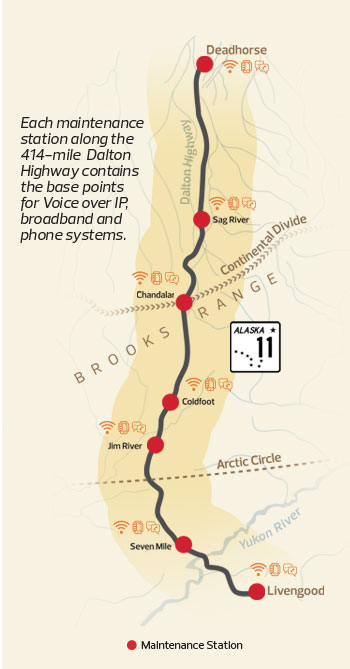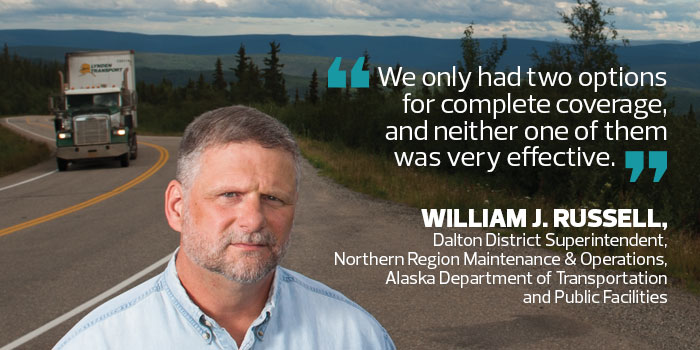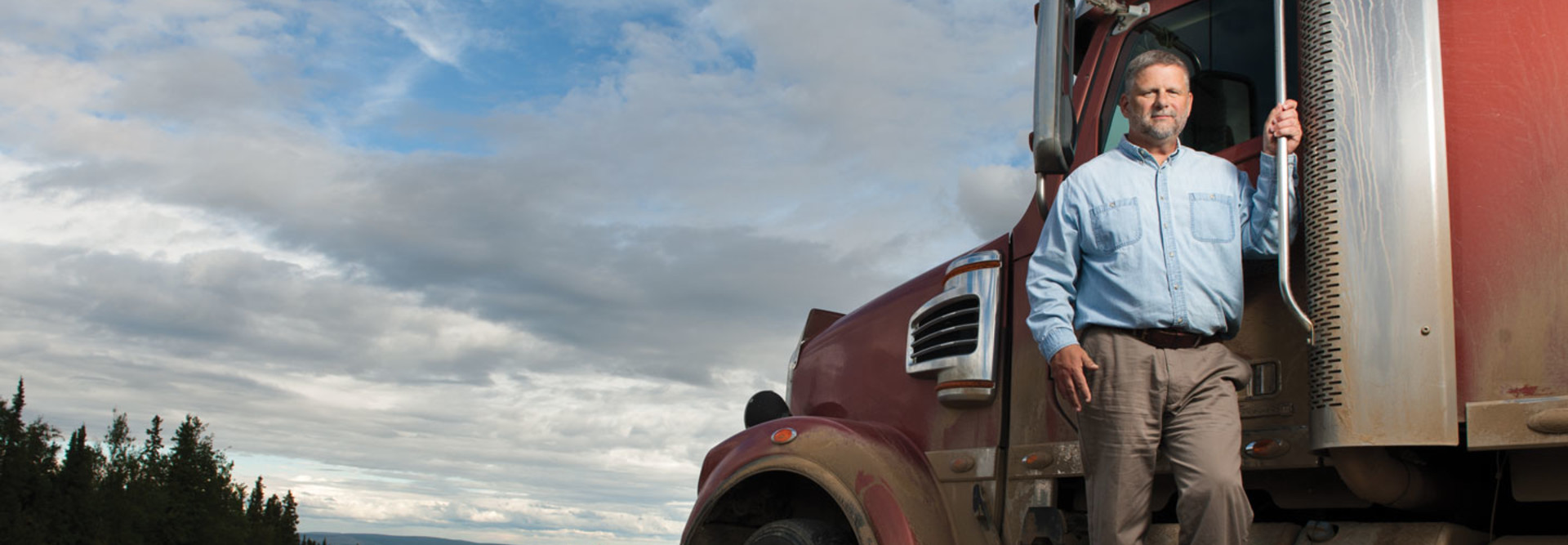In Tough Terrain, State and County Officials Get Creative to Extend Networks
The Dalton Highway in northern Alaska is famous for being one of the most isolated, dangerous roads in America. The 414-mile route, used primarily by truckers hauling supplies to oilfields near the Arctic Ocean, features steep grades, few human inhabitants and just one medical facility.

Drivers are encouraged to bring survival gear: Blizzards and subzero temperatures can swoop in without warning, and those stranded by equipment failure or a wrong turn of the wheel can quickly find themselves in a life-threatening predicament.
Until recently, the highway’s innate dangers were exacerbated by the fact that drivers and state workers had only limited short-range communications capability, says William J. Russell, Dalton District Superintendent, Northern Region Maintenance & Operations, Alaska Department of Transportation and Public Facilities (ADOT&PF).
“We only had two options for complete coverage, and neither one of them was very effective,” he says, recalling one occasion when it took more than a day to round up an emergency response to a driver’s call for help. “Satellite phones would drop out pretty quickly because satellites don’t stay above the horizon very long here, and radio phones were so unreliable that we never used them at all.”
Network Upgrade Proves to Be a Lifesaver
Russell and his IT team went in search of a creative solution.
“Our goal initially was just to have radio communications up and down the highway, but what we ended up with was that, plus phone and internet,” he says.
To do this, they first leveraged 19 existing high-tower sites that were equipped with microwave technology. “We were able to rent space and power and put our system within their structure,” Russell says.
Next, they looked for a way to upgrade and combine their phone and networking capability, so users could communicate within and across all of the ADOT&PF maintenance camp stations along the route.
The state of Alaska had already installed a Cisco Systems network throughout the northern region, except in the Dalton District. So technology officials took that existing network topology and built a solution for Dalton that included the current Cisco routers, switches and interface cards while integrating Land Mobile Radio components and the latest version of Cisco’s Instant Connect.
The latter tied together voice and data communications for Voice over IP and email capability but also provided simple push-to-talk capability. Now any user carrying a wireless IP phone can instantly communicate with one station or all of them at the same time.

Although it’s still risky out on the Dalton Highway, the new network has been a boon for life safety, says Russell. Shortly after the new system went live, two truckers on the road about 60 miles out of Deadhorse were involved in a head-on collision. An ADOT&PF plow truck driver happened upon the scene and immediately got on his phone to contact Russell.
“I was 700 miles away, but I was able to get in touch with the right people immediately, rally up a response and get everybody mobilized and out there to help in a pretty fast and furious manner,” Russell says. “So it’s made for a huge improvement in our ability to know what’s going on out there and to respond. I have no doubt that there will be situations where our ability to communicate effectively will be the difference between life and death.”
States Can Leverage Piggyback Tactics
States and localities are under more pressure than ever to provide seamless communications and broadband connectivity everywhere — no matter how far-flung or challenging the environment. Fortunately, says Christopher Mitchell, director of the community broadband networks initiative for the Institute for Local Self-Reliance, the factors to make that happen are all coming together.
For starters, he says, there’s the potent combination of skyrocketing demand and technology innovations — including more reliable and higher capacity wireless — that’s lowering the cost of deploying networks exponentially with each passing year. Another factor is the growing footprint of available “middle mile” infrastructure that rural areas can leverage, thanks to a $7 billion federal stimulus program and investments by electric and phone co-ops, utilities and commercial broadband providers.
“The key is to look for opportunities to piggyback onto what’s already been built,” says Mitchell. He notes that some rural areas actually have faster and more robust infrastructure than many cities, though its availability is usually uneven. “If you can interconnect with a power co-op or another organization, you no longer have to think about building a 100-mile network across your county; you just have to build a three-mile network to that existing infrastructure.”
Smart Network Infrastrucure Planning Pays Off
No one has used this so-called “collaborate intensely and dig once” strategy better than Dakota County, Minn. This 562-square-mile area is home to 11 cities, but also an expansive swath of rustic countryside and open farmland bordered by the Mississippi and Minnesota rivers.
Over the past several years, the county’s IT team, led by Network Collaboration Engineer David Asp, has put in place a lightning-fast, 353-mile redundant fiber network connecting 450 sites, including county agencies, parks, schools, first responders, traffic signals and utilities. The network has saved the county nearly $20 million — what it would have otherwise paid to phone and internet providers.
Asp notes that the county has been extremely creative and thorough in its resourcefulness.
“I look at everything from the county’s interest and figure out how we can make that overlap or coincide with the interests of others,” he says. “Whenever I plan a network route through rural areas, I get out a map and figure how I can take it past, for example, a National Guard unit, a school, a power substation or traffic signals.”
By doing that, Asp and his team can leverage existing infrastructure, qualify for federal or state funds, or partner with other organizations. As an example, the tiny town of Farmington had long ago installed conduit and 12 strands of fiber to its school. Asp and his team offered to replace that infrastructure with 144 fiber strands in exchange for right-of-way access and use of extra-capacity fiber.
“That allowed us to then tie into another neighboring community,” Asp says, noting that he and his team made a $1.25 million bulk purchase of fiber at a 25 percent discount that enables these types of trades. “Then we go in, use our expertise, leverage federal grants that we get for hooking up traffic signals, build out the entire community with fiber optics and then lease that back to the local government for their critical services.”
New Network Enhances Remote Supervision
Dakota County also needed to extend networking capability deep into its most isolated regions, where agencies and county assets still relied on basic dial-up service.
“We spent a lot of time just trying to troubleshoot and fix stuff because they didn’t have the connectivity they needed,” Asp says.
County deputies, for example, had to go out of their way to the remote southern border to check for flooding at the county-owned, electricity-generating Lake Byllesby Dam and Reservoir. Getting the network into that area required collaborating with the state transportation department and a local rural broadband company to lay fiber along rural roads and build above-ground infrastructure in areas thick with bedrock.
Today, with the new network in place, officials keep tabs on the dam via live video feed and a web-enabled notification system.
“We’re still working continuously to connect more sites and improve access,” Asp says. “But we’ve saved a lot of money, and we’re now able to do our everyday business very efficiently, throughout the county.”








